Henderson tells Jenkins: “Far the best of the Victorian marine painters show come from the Duport collection.” [HSH 233/252] Of course, Jenkins had seen these paintings years before and disdained them. Now we have a few more clues to their appearance. The newspaper review of the exhibition had praised the ‘virtuosity’ and ‘tightness of finish’ of Gannets Nesting, The Needles: Schooner Aground, and Angry Seas at Land’s End. [HSH 227/246]
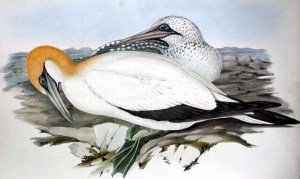
Australian Gannet
John Gould, 1840-1848
hand colored lithograph from Birds of Australia,
Vol. 7 (n1-a.7): plate 76
Image from Glasgow University Special Collections Department
John Gould (1804-1881), like his contemporary James Audubon, was a skilled illustrator of birds. He published eight folios of Birds of Australia and many other folios of birds from all over the world, containing over 3000 color plates of birds. His work would merit the critic’s praise of virtuosity and finish.
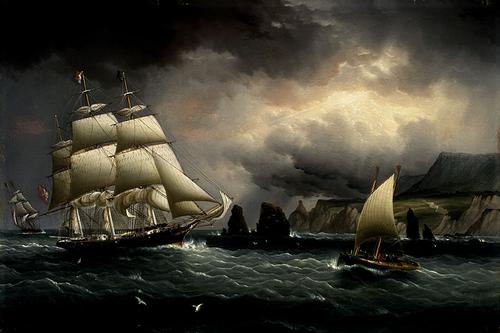
The Clipper Ship “Flying Cloud” off the Needles, Isle of Wight
John Buttersworth, 1859-1860.
oil on panel, 12 x 18 in
Memorial Art Gallery, U. of Rochester, N.Y
photo in public domain from Wikipedia.org
The Needles are chalk stacks off the Isle of Wight, which are part of a chalk ridge running to Dorset. They have been the sight of many shipwrecks. This picture (left) of the wreck of the Irex, which occurred on January 25,1890, shows The Needles in a diagonal line pointing toward the horizon. We have been unable to identify the artist. A better known painting of The Needles is The Clipper Ship “Flying Cloud” by James Butterworth. The Flying Cloud held the record for the fastest passage under sail from New York to San Francisco and itself went aground off New Brunswick in 1874. Butterworth (1817-1894) was British but specialized in portraits of American ships. Our first reaction was that with Butterworth’s skill for detail and drama, his work could not have been in the Duport collection, but we became less certain of our opinion, when we read that Jenkins revised his prior
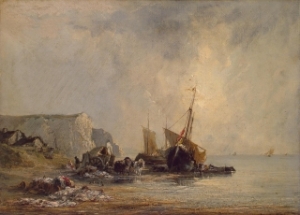
Boats near the Shore of Normandy
Richard Parkes Bonington, 1823-24
ol on canvas, 13 x 18 in
The Hermitage
view of the seascape: “The Needles: Schooner Aground was by no means without merit. The painter had evidently seen the work of Bonington.” [HSH 238/257]. Richard Parkes Bonington (Britsh 1802-1828) was a romantic landscape and seascape painter. He won a gold medal, as did John Constable, at the Paris Salon on 1824. So in the end, Jenkins admits that for all his sarcasm and fussiness about some works, he joins those who reassess work as time passes and tastes change.
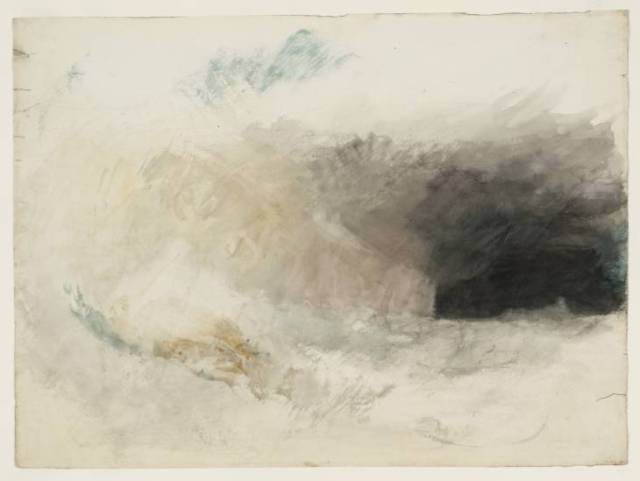
The Longships Lighthouse, Land’s End, from the North-East
Joseph Mallord William Turner, ~1834
watercolor on white wove paper, 11 x 17 in
The Tate, London
Jenkins “was less keen on Angry Seas off Land’s End.” [HSH 238/257], so perhaps the rendition of that subject in the Duport Collection was not so masterly as this J. M. W. Turner vision of the powerful waves off Land’s End.
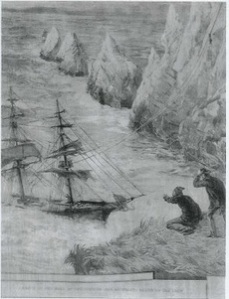
While John Gould made the preliminary sketches for many of the birds and mammals depicted in his published portfolios, he was primarily a zoologist and entrepreneur. The finished images in his publications were the work of a range of artists, notably his wife Elizabeth Gould, Edward Lear, Josef Wolf and Henry Constantine Richter. See .